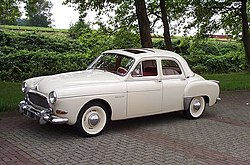Renault Frégate
| Renault Frégate | |
|---|---|
 | |
| Overview | |
| Manufacturer | Renault |
| Also called | Renault Domaine |
| Production | 1951-1960 |
| Assembly | Flins, France Israel[citation needed] |
| Body and chassis | |
| Class | full-size car large car |
| Body style | 4-door saloon 5-door estate |
| Layout | FR layout |
| Powertrain | |
| Engine | 1996 cc straight-4 2141 cc Etendard straight-4 |
| Transmission | 4 speed manual, 'Transfluide' semi automatic 3 speed optional from 1957 |
| Dimensions | |
| Wheelbase | 2,800 mm (110 in)[1] |
| Length | 4,700 mm (185.0 in) |
| Width | 1,720 mm (67.7 in) |
| Height | 1,540 mm (60.6 in) |
| Curb weight | 1,230 kg (2,712 lb) |
| Chronology | |
| Predecessor | Renault Vivastella |
| Successor | Renault Rambler Classic |
The Renault Frégate is a full-size or executive car produced by the French automaker Renault between 1951 and 1960.
The Frégate was conceived in the years immediately following World War II. Renault, which then had recently been brought under control of the French state, needed a new modern, upmarket model to both improve its image and to cater to the needs of consumers in the quickly recovering economy. Several prototypes were produced before the Frégate design was put into production: initially, the car had a rear-engined layout as in the recently launched Renault 4CV but eventually the manufacturer decided to go with an engine mounted ahead of the driver. The Frégate was unveiled at the 1950 Paris Motor Show but the first model was not delivered until November 1951: production built up only slowly. The assembly plant at Flins where the car was constructed, which had been renamed after the recently deceased Pierre Lefaucheux, was only formally opened in October 1952.[2]
The Frégate was initially available in two trim levels, Affaires and Amiral. Renault addressed the complaints about the lack of power from the 2 litre engine by introducing the new 2141 cc Etendard engine in 1956, which produced 77 hp (57 kW). A popular estate model badged Domaine was also launched in 1956, along with the new, luxurious Grand Pavois specification. In 1957 a three speed 'Transfluide' semi-automatic transmission, incorporating a fluid coupling, became an option along with a slightly more powerful version of the 2141 cc engine for which 80 bhp (60 kW; 81 PS) was claimed in this combination.
1958 saw another modified front grill: the prominent wide chrome oval and horizontal bars were removed to leave only the row of thin bars over which, since 1955, they had been placed.
Nevertheless, the market for larger saloon cars had been taken by storm in 1955 when Citroën had introduced their futuristic DS, followed in 1957 by a more aggressively priced ID variant: sales of the Frégate gradually declined throughout the 1950s and production ceased in 1960. In total, 163,383 Frégates were made in Flins, France.
Beginning in 1962 Renault began selling the Rambler Classic as the “Renault Rambler Classic” as something of a replacement for the Frégate.[3]
Pierre Lefaucheux
Ironically, Pierre Lefaucheux, who had succeeded Louis Renault after his arrest and subsequent death to become director of the now nationalized Regie Renault — died in a car accident near Saint-Dizier when he lost control of his Renault Frégate on an icy road and was struck on the head by his own unsecured brief case [2] as the car rolled over. By then he had also overseen most of the development of the Renault Dauphine which would be presented at the Geneva Motor Show in March 1956.
-
Rear view of a 1959 Transfluide saloon
-
Interior of a 1959 Transfluide saloon
-
Renault Domaine in ambulance livery
References
- ^ Gloor, Roger (1. Auflage 2007). Alle Autos der 50er Jahre 1945 - 1960. Stuttgart: Motorbuch Verlag. ISBN 978-3-613-02808-1.
{{cite book}}: Check date values in:|year=(help); Cite has empty unknown parameter:|coauthors=(help)CS1 maint: year (link) - ^ a b "Thirty Remarkable years of Renault". Autoworld. 45: Page 11. date April 1974.
{{cite journal}}: Check date values in:|date=(help) - ^ "the graveyard of forgotten cars" French site. Retrieved on March 8th 2020



